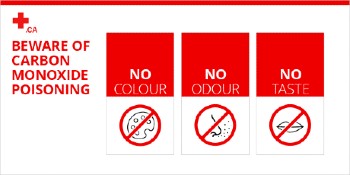Every year, hundreds of Canadians are affected by carbon monoxide poisoning. The results can be fatal.

Carbon monoxide (CO) is an odourless, colourless, and tasteless gas, and therefore not detectable by any of the body’s senses. Because of its indiscernible nature, carbon monoxide poisoning is sometimes known as a “silent killer”. CO poisoning happens when someone breathes in too much carbon monoxide.
The gas is found in fumes produced by burning fuel such as oil, propane, gasoline, or even wood, in appliances and equipment that include:
- Small engines
- Lanterns
- Fireplaces
- Stoves
- Grills
- Gas ranges
- Furnaces
- Cars
- Trucks
Here are some tips for preventing and recognizing carbon monoxide poisoning:
Prevention
- Install a battery-operated or battery back-up carbon monoxide detector in an area where the alarm will be easily heard
- Check or replace the detector’s batteries at least twice a year
- Have all fuel-based appliances and equipment installed and repaired by a qualified technician
- Have all fuel-based appliances and equipment serviced annually by a qualified professional
- Use all fuel-based appliances and equipment as intended (e.g. do not use outdoor equipment indoors)
- Ensure that chimneys are inspected and cleaned by a professional annually
- Never run a vehicle inside a garage attached to a house.
- For detached garages, always leave the garage door open when running a car or truck inside
Carbon monoxide poisoning symptoms are commonly described as “flu-like”. Signs and symptoms include:
- Headache
- Dizziness
- Confusion
- Weakness or fatigue
- Impaired hearing and vision
- Nausea and vomiting
- Chest pain
- Altered level of responsiveness
If the person you suspect to have carbon monoxide poisoning is responsive and alert, call the local Poison Control Centre. Call EMS/911 and get an AED if the person has an altered level of responsiveness or has difficulty breathing.
If the person is not breathing, start CPR. Use a barrier device so that you don’t contaminate yourself with the poison.
Get the person into fresh air, but do not enter into a hazardous atmosphere in order to do so.
You can learn more about carbon monoxide poisoning on this Government of Canada page.
And, for handy resources at your fingertips, you can also download our First Aid app.
Make sure you’re prepared for common first aid emergencies; and find a class near you!
Related:
Beware of the silent killer: how to prevent carbon monoxide poisoning
Generator safety

